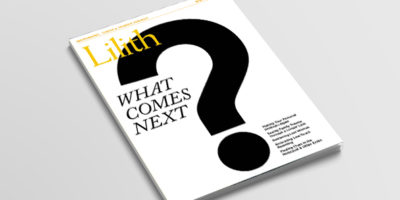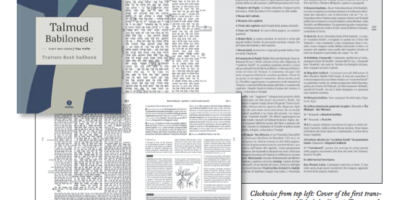A Feminist Lens On Books For Young Readers
(A roundup brought to you periodically by Lilith)
“You could say that Ruth Bader Ginsburg’s life has been… one disagreement after another,” begins picture-book bio I Dissent: Ruth Bader Ginsburg Makes Her Mark by Debbie Levy, illustrated by Elizabeth Baddeley, (Simon & Schuster, $17.99). It highlights Ginsburg’s determination in the face of restrictions, barriers and prejudices. She was a left-handed elementary school pupil told she must write with her right hand and a vacationer who, with her parents, saw hotel signs reading “No dogs or Jews allowed.” She was encouraged by her mother, who took her to the library to learn through books to help her excel in her studies. As a law student, a job seeker, a mother and a Jew, this first Jewish woman to serve on the U.S. Supreme Court—and right now the oldest serving Justice—is a vigilant fighter for equal opportunity for all.
So, too, is the 12-year-old righteous gentile Marcel, in Occupied France during World War II, who dreams of cycling one day in the Tour de France. Hero of historical middle-grade novel The Bicycle Spy (Scholastic, $16.99) by Lilith fiction editor (and Francophile) Yona Zeldis McDonough, Marcel is an inspiring boy whose baker parents are active in the Resistance. Sent by his parents on missions of which he is at first unaware (for his own protection), Marcel rides his bike to deliver baked goods with secret messages hidden inside. Marcel is befriended by a lively new female classmate, also a bicycle enthusiast and expert bicycle fixer, who is suddenly in great danger when it becomes known to a bullying classmate that she is Jewish. Marcel is instrumental in making her family’s escape possible, courageously taking risks, along with his parents, to help someone in danger get to safety.
Another story inspired by real (uncatastrophic) life, is Potatoes at Turtle Rock by Susan Schnur (whose writing in Lilith is very familiar to our readers ) and Anna Schnur-Fishman (ditto) illustrated by Alex Steele-Morgan (Karben, $17.99). Following the same family as Tashlich at Turtle Rock (2010), the story this time has young Annie in charge of a nighttime Hanukkah hike with stops at favorite spots, accompanied by farmyard pets. Including riddles and family lore, this story delivers familial affection and ritual creativity for a chilly night.
Also set in a loving family, Preaching to the Chickens: The Story of Young John Lewis, by Jabari Asim, illustrated by E.B. Lewis, tells how John, whose farm chore it is to take care of the chickens, names them, rescues them from barnyard mishaps, and practices his skills at orating. The chickens listen contentedly as he emulates the preachers who inspire him at the Sunday church services he attends with his family. This story is based on anecdotes from a memoir by the revered civil rights leader and Georgia congressman.
Jabari and Lewis’s book joins my pantheon of two older favorite books featuring chickens. One is Chicken Man (1991), an affectionate look at job rotation and kibbutz life written and illustrated by Michelle Edwards, who has written a new book, illustrated by G. Brian Karas, A Hat for Mrs. Goldman: A Story About Knitting and Love (Schwartz & Wade, $17.99). It too is an example of a young person inspired by an elder, in this case a kindly and generous neighbor who teaches Sophia to knit. A sweet and satisfying story.
And back to the favorite chicken books for a moment. The other is Beautiful Yetta the Yiddish Chicken (2010) by Daniel Pinkwater, a multilingual (English, Yiddish and Spanish) story of finding a home in the urban jungle of Brooklyn.
And in the realm of Brooklyn and the cross-cultural, we have picture book-tribute in verse by Andrea Davis Pinkney, illustrated by Steve Johnson and Lou Fancher, A Poem for Peter: The Story of Ezra Jack Keats and the Creation of the Snowy Day (Viking, $18.99). “Brown Sugar Boy in a blanket of white. Bright as the day you came onto the page. From the hand of a man who saw you for you.” Keats (1916–1983), born Jacob Ezra Katz to a Jewish immigrant family in Brooklyn, knew from his own experience as a Jew what it meant to face discrimination and to feel left out.
His beloved 1962 picture book was the first—without fanfare or fuss, and with great beauty—to feature a black child in a contemporary urban setting.
New Books About Girls & Science
Picture book Ada Twist, Scientist by Andrea Beaty, illustrated by David Robert (Abrams $17.95) “Why does it tick and why does it tock?/Why don’t we call it a granddaughter clock?/Why are their pointy things stuck to a rose?/Why are there hairs up inside of your nose?/She started with Why? and then What?/ How? and When?/By bedtime she came back to Why? once again./She drifted to sleep as her dazed parents smiled/at the curious thoughts of their curious child,/who wanted to know what the world was about./They kissed her and whispered, ‘You’ll figure it out’.”
Finding Wonders:Three Girls Who Changed Science by Jeannine Atkins (Atheneum $16.99), also in verse, for middle grade readers, tells the story of three girls, who lived centuries apart in Germany, England and the United States, who studied, respectively, the metamorphosis of caterpillars, fossils, and comets.
In Trailblazers: 33 Women in Science Who Changed the World by Rachel Swaby (Delacorte, $15.99), older young readers learn that a few of the indomitable scientists here felt double discouragement and discrimination as females and as Jews: Rita Levi-Montalcino, Rosalind Franklin, Rosalyn Sussman Yalow.
Naomi Danis





